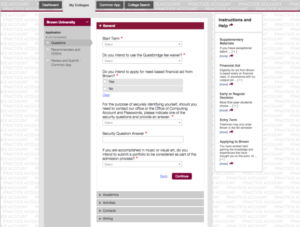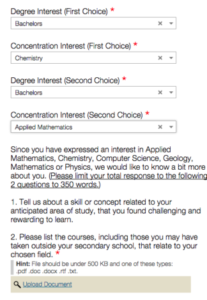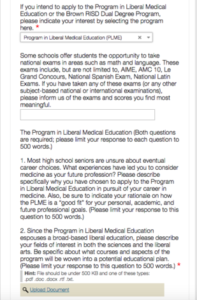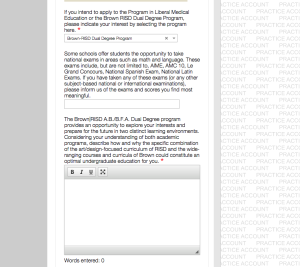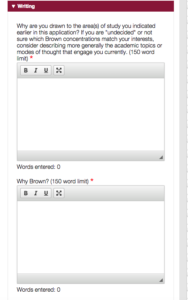The Ultimate Guide to Applying to Brown University
Located in the vibrant College Hill Historic District of Providence, Rhode Island, Brown University is the seventh-oldest institution of higher learning in the United States, founded in 1764 as “The College in the English Colony of Rhode Island and Providence Plantations,” one of the nine Colonial Colleges established before the American Revolution.
One of eight Ivy League colleges, Brown offers more than 2,000 courses across more than seventy concentrations. One of its unique features is that it offers an open curriculum, in which students are not required to take any General Education requirements. However, there may be course or distribution requirements within specific majors. Additionally, all Brown undergraduates must fulfill a two-part writing requirement, including at least one writing-focused course.
Students also have the freedom to create their own academic concentrations with guidance and approval from faculty members. Some of the most popular majors include biology/biological sciences, economics, computer science, history, and neurosciences, along with special programs highlighted below.
Want to learn what Brown University will actually cost you based on your income? And how long your application to the school should take? Here’s what every student considering Brown University needs to know.
Statistics and Basic Information
Brown is an extremely selective school. For the class of 2019, it received 30,397 applicants and offered admission to 2,580 students, for an acceptance rate of 8.5%. Brown also accepts a very small number of waitlisted candidates, typically notifying them of decisions by mid-May. Typically, about 400-500 students are waitlisted, and in recent years, between zero and 196 students were admitted per year from the waitlist.
Brown’s application deadlines are November 1st for Early Decision and January 1st for Regular Decision. Early Decision applicants will receive admissions decisions in mid-December, and Regular Decision applicants will be notified by the end of March. Brown’s Early Decision program is binding, meaning applicants who are accepted through this plan are required to matriculate at Brown; however, if your admissions decision is deferred, meaning you will be considered with the pool of Regular Decision candidates, you are not required to attend if accepted. Students accepted through the Regular Decision plan must notify Brown of their final decision by May 1st.
Like the other Ivies, Brown does not offer merit-based financial aid, but does offer need-based aid, with need blind admission, meaning an applicant’s ability to pay for his or her education will not be a determining factor in admission. The CSS Profile and FAFSA deadlines are November 1st for Early Decision and February 1st for Regular Decision. Tuition costs $25,112/semester or $50,224/year, with a total expected cost of $34,053/semester or $68,106/year, including room, board, books, personal costs, and other fees.
Applying to Brown
Brown uses the Common Application with a required supplement. Applicants must submit either the SAT and any two SAT Subject Tests (code 3094) or the ACT (code 3800). Applicants may request recommendations from their guidance counselor and two teachers who taught them in major subjects via email through the Common Application. Brown recommends that at least one of your recommendations come from a math or science teacher if you are considering a Bachelor of Science degree or PLME (see below for more information).
Brown accepts additional materials, which can be uploaded to your file once you receive an account username, but recommends that you you do not send award certificates or similar materials. You will have the opportunity to describe awards in the Common Application.
After Brown receives your application, an Alumni volunteer will contact you to set up an interview. Some areas host events during which applicants may choose a time slot to meet with an alum; in this case, you will be contacted by an area coordinator. Your interviewer will not receive your application materials, and will only know your contact information and intended concentration. You are not expected to bring transcripts, resumes, or any other materials to your interview. Because an interview is a great opportunity to demonstrate your strengths and interest in the school, as well as to learn more about Brown, you should consider meeting with an alum if possible. Brown does not conduct on-campus interviews, and if you are unable to meet with an alum, it will not negatively impact your application.
Supplement to the Common Application
The Brown supplement to the Common Application includes five sections: General, Academics, Activities, Contacts, and Writing.
General
Here, you will be asked basic questions, including your intended start term and whether you will be applying for financial aid. Brown only offers admission for a Fall start term, so you will have one option here. You will also be asked if you intend to use a Questbridge fee waiver. You should only select that you are a finalist if you are in fact participating in Questbridge.
If you are exceptionally talented in music or visual art, you are encouraged to submit a portfolio. You will be asked if you would like to submit a portfolio, and are given an instructions link in the sidebar.
Academics
In this section, you will be asked for two intended concentrations (majors). Keep in mind that this is not set in stone. If admitted, you will not need to declare a major until the end of your Sophomore year. The admissions committee just wants to have an idea of what kind of areas the students in its matriculating class intend to study for demographics purposes and to ensure the student body is as diverse as possible.
If you express interest in majoring in Applied Mathematics, Chemistry, Computer Science, Geology, Mathematics, or Physics, you will be required to answer two addition questions in this section with a combined word limit of 350 words:
- Tell us about a skill or concept related to your anticipated area of study, that you found challenging and rewarding to learn.
- Please list the courses, including those you may have taken outside your secondary school, that relate to your chosen field.
Brown boasts several nontraditional and highly prestigious programs for undergraduates, including the Program in Liberal Medical Education (PLME), an eight-year combined undergraduate education and professional studies in medicine program that accepts about ninety strongly motivated students.
If you plan to apply to the PLME program, you will be asked two additional questions in the supplement to the Common Application:
- Most high school seniors are unsure about eventual career choices. What experiences have led you to consider medicine as your future profession? Please describe specifically why you have chosen to apply to the Program in Liberal Medical Education in pursuit of your career in medicine. Also, be sure to indicate your rationale on how the PLME is a “good fit” for your personal, academic, and future professional goals. (Please limit your response to this question to 500 words.)
- Since the Program in Liberal Medical Education espouses a broad-based liberal education, please describe your fields of interest in both the sciences and the liberal arts. Be specific about what courses and aspects of the program will be woven into a potential educational plan. (Please limit your response to this question to 500 words.)
Brown also offers a five-year Dual Degree program with the Rhode Island School of Design (RISD), in which students have the opportunity to earn degrees from both institutions. This program is highly selective, with an acceptance rate of 3.3% in 2015. Prospective students must apply and be accepted to both schools separately before being approved by a third joint committee.
If you plan to apply to the Brown/RISD A.B./B.F.A. Dual Degree program, you will be asked one additional question on the Brown supplement to the Common Application:
The Brown/RISD A.B./B.F.A. Dual Degree program provides an opportunity to explore your interests and prepare for the future in two distinct learning environments. Considering your understanding of both academic programs, describe how and why the specific combination of the art/design-focused curriculum of RISD and the wide-ranging courses and curricula of Brown could constitute an optimal undergraduate education for you.
Since these programs are so prestigious, you must be a student of the highest caliber in order to be admitted. These questions will help the admissions committee see your passion and dedication to the subjects and give them a greater understanding of your commitment. They also want to see how the blend of a liberal arts education with a heavy sciences or visual arts focuses appeals to you specifically.
Activities
Since the Common Application has a limit of 150 characters for each description in the standard activities section, Brown allows you to elaborate in its supplement.
Please briefly elaborate on one of your extracurricular activities or work experiences. (150 word limit)
This is an excellent opportunity to expand on an activity that is particularly meaningful to you. Choose one of the activities you listed in your application and explain why it is especially important. Try not to repeat what you already said—this is a chance for you to go further. Instead of further explaining your tasks and duties, tell the admissions committee why this activity stands out to you and and how it has shaped you.
You can also upload your resume here, so if you want to include more activities or longer descriptions than you were allowed in the Activities section, this is a great opportunity to so.
Contacts
Here you will be asked if you previously applied to Brown and how you found out about the school. You will also have the opportunity to enter your cell phone number if you would like to be contacted via calls or text messages.
Writing
The Writing section asks questions specific Brown. For a comprehensive overview of the best approaches for answering these questions, refer to our post on how to write the Brown University essays. Below are some key points to consider.
Why are you drawn to the area(s) of study you indicated earlier in this application? If you are “undecided” or not sure which Brown concentrations match your interests, consider describing more generally the academic topics or modes of thought that engage you currently. (150 word limit)
Given the space requirement, you will need to be concise and offer only the most salient points. You may want to highlight one important aspect of your interest in your chosen concentration.
Why Brown? (150 word limit)
As with the prompt above, you do not have room to offer a full essay on your interest in Brown. However, considering Brown’s many unique features, you do have room to highlight a few key areas.
Tell us where you have lived – and for how long – since you were born; whether you’ve always lived in the same place, or perhaps in a variety of places. (100 word limit)
Although Providence is a small city, it is a place with a lot of culture and personality, so it’s no surprise Brown wants to know about the place you call home. This is an opportunity to demonstrate something unique about yourself. While it asks about location on the surface, consider digging deeper and revealing a unique characteristic or attribute of yourself.
We all exist within communities or groups of various sizes, origins, and purposes; pick one and tell us why it is important to you, and how it has shaped you. (100 word limit)
Because of the limited space here, you should focus on your involvement in a specific group, rather than what the group is and does. Again, this is a question about you, not the larger group. Try to think broadly in terms of defining what a community is—it doesn’t necessarily have to pertain to an ethnicity or religion, but could also be an extracurricular activity or your family or friends.
With these tips, you should be well on your way to crafting a stellar application to Brown.
Curious about your chances of acceptance to your dream school? Our free chancing engine takes into account your GPA, test scores, extracurriculars, and other data to predict your odds of acceptance at over 500 colleges across the U.S. We’ll also let you know how you stack up against other applicants and how you can improve your profile. Sign up for your free CollegeVine account today to get started!
